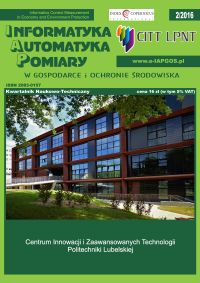ANALYSIS OF THE ELECTRIC FIELD DISTRIBUTION IN THE DRUM SEPARATOR OF DIFFERENT ELECTRODE CONFIGURATION
Article Sidebar
Open full text
Issue Vol. 6 No. 2 (2016)
-
TOPOLOGICAL DERIVATIVE METHOD FOR ELECTRICAL IMPEDANCE TOMOGRAPHY PROBLEMS
Andrey Ferreira, Antonio Novotny, Jan Sokołowski4-8
-
MODIFIED ALTERNATIVE DECISION RULE IN THE PRE-CLUSTERING ALGORITHM
Volodymyr Mosorov, Taras Panskyi, Sebastian Biedron9-12
-
IMPROVED MOTION TYPE IDENTIFICATION METHOD USING MOBILE DEVICE SENSORS
Jakub Smołka, Przemysław Troć, Maria Skublewska-Paszkowska, Edyta Łukasik13-18
-
SWIRL FLOW ANALYSIS BASED ON ELECTRICAL CAPACITANCE TOMOGRAPHY
Ayoub Saoud, Volodymyr Mosorov, Krzysztof Grudzień19-23
-
INFORMATICS SYSTEM FOR CONCENTRATION STATE ANALYSIS ON THE BASIS OF A DEVICE OPERATING IN THE BRAIN – COMPUTER INTERFACE TECHNOLOGY
Szczepan Paszkiel24-27
-
DECISION SYSTEM FOR STOCK DATA FORECASTING BASED ON HOPFIELD ARTIFICIAL NEURAL NETWORK
Michał Paluch, Lidia Jackowska-Strumiłło28-33
-
SIMULATION OF GRAVITATIONAL SOLIDS FLOW PROCESS AND ITS PARAMETERS ESTIMATION BY THE USE OF ELECTRICAL CAPACITANCE TOMOGRAPHY AND ARTIFICIAL NEURAL NETWORKS
Hela Garbaa, Lidia Jackowska-Strumiłło, Krzysztof Grudzień, Andrzej Romanowski34-37
-
THEORETICAL ANALYSIS OF GENERATION AND COMPENSATION OF REACTIVE POWER IN PHOTOVOLTAIC POWER PLANTS
Michal Koníček, Boris Cintula38-41
-
LOW POWER DC/DC CONVERTER FROM 3 KV TO 300 V – SIMULATION ANALYSIS
Wojciech Matelski42-47
-
DESIGN AND FEATURES ANALYSIS OF GENERALIZED ELECTRONIC CONTENT-COMMERCE SYSTEMS ARCHITECTURE
Victoria Vysotska, Lyubomyr Chyrun48-59
-
APPROXIMATION OF THE FLUX-CURRENT CHARACTERISTIC OF THE ELECTROMECHANICAL ACTUATOR BASED ON MEASUREMENT RESULTS
Zygmunt Kowalik60-63
-
HOW DO WE DEFINE CYBERCRIME?
Monika Zbrojewska, Volodymyr Mosorov, Sebastian Biedron, Taras Panskyi64-68
-
NOISE MEASUREMENTS AND ENVIRONMENTAL IMPACT ASSESSMENT OF WIND TURBINES
Hanna Pamuła, Maciej Kłaczyński69-74
-
HYBRID ELECTROMAGNETIC LAUNCHER WITH COILGUN AS CURRENT LIMITER IN RAILGUN
Tomasz Makowski75-78
-
ANALYSIS OF THE ELECTRIC FIELD DISTRIBUTION IN THE DRUM SEPARATOR OF DIFFERENT ELECTRODE CONFIGURATION
Mikołaj Skowron, Mikołaj Skowron79-82
-
APPLIED GLONASS OBSERVATIONS IN PPP METHOD IN AIRBORNE TEST IN MIELEC
Kamil Krasuski, Henryk Jafernik83-88
Archives
-
Vol. 8 No. 4
2018-12-16 16
-
Vol. 8 No. 3
2018-09-25 16
-
Vol. 8 No. 2
2018-05-30 18
-
Vol. 8 No. 1
2018-02-28 18
-
Vol. 7 No. 4
2017-12-21 23
-
Vol. 7 No. 3
2017-09-30 24
-
Vol. 7 No. 2
2017-06-30 27
-
Vol. 7 No. 1
2017-03-03 33
-
Vol. 6 No. 4
2016-12-22 16
-
Vol. 6 No. 3
2016-08-08 18
-
Vol. 6 No. 2
2016-05-10 16
-
Vol. 6 No. 1
2016-02-04 16
-
Vol. 5 No. 4
2015-10-28 19
-
Vol. 5 No. 3
2015-09-02 17
-
Vol. 5 No. 2
2015-06-30 15
-
Vol. 5 No. 1
2015-03-31 18
-
Vol. 4 No. 4
2014-12-09 29
-
Vol. 4 No. 3
2014-09-26 22
-
Vol. 4 No. 2
2014-06-18 21
-
Vol. 4 No. 1
2014-03-12 19
Main Article Content
DOI
Authors
Abstract
The static electric field is used in many industrial processes, such as electrostatic separation process. One of the devices that uses a difference in electrical properties of the particles is drum separator. In this device, particles of varying conductivity are electrified in the corona zone and fall on the drum. The particles of high conductivity lose their charges and brake off the drum while the particles of small conductivity keep their charges and are held on the drum surface. To determine the effectiveness of separation is necessary to determine the particle trajectories. Trajectories of separated particles are affected by many factors, among which the most important are: the electrodes configuration, value of high voltage (both factors determine the distribution of the electric field between the electrodes). The article presents the results of analysis of a distribution of the electric field in the drum separator for different configurations of electrodes and the applied voltage.
Keywords:
References
Cieśla A.: Dynamiczne działanie pól: elektrycznego i magnetycznego w elektrotechnologiach (na przykładzie separacji). Prace Instytutu Elektrotechniki 2007, 81–93.
Jiang W., Li J., Xu Z.: A new two-roll electrostatic separator for recycling of metals and nonmetals from waste printed circuit board, Journal of Hazardous Materials 161, 2009, 257–262.
Li J., Xu Z., Zhou Y.: Application of corona discharge and electrostatic force to separate metals and nonmetals from crushed particles of waste printed circuit boards. Journal of Electrostatics 65, 2007, 233–238.
Li J., Lu H., Liu S., Xu Z.: Optimizing the operating parameters of corona electrostatic separation for recycling waste scraped printed circuit boards by computer simulation of electric field. Journal of Hazardous Materials 153, 2008, 269–275.
Veit H.M., Diehl T.R., Salami A.P., Rodrigues J.S., Bernardes A.M., Tenorio J.A.S.: Utilization of magnetic and electrostatic separation in the recycling of printed circuit boards scrap. Waste Management 25, 2005, 67–74.
Article Details
Abstract views: 317
License

This work is licensed under a Creative Commons Attribution-ShareAlike 4.0 International License.






